Coming of Age in the Twentieth Century, Stories from Minnesota and Beyond
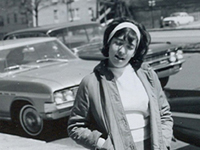
This website explores "girls' history" with 40 oral history interviews conducted by women's studies students at Minnesota State University-Mankato. Each interviewee was asked extensively about her girlhood. Questions focused on adolescence and growing up as well as the social, cultural, and physical implications of girlhood and personal experiences. Topics include family, race, sexuality, education, and women's issues. The archive includes brief biographies, video clips, and transcripts of interviews (arranged thematically), photographs, and reflections of the interview process. Most of the women interviewed were born and raised in Minnesota, although a few came from other states with a smaller number immigrating from other countries. The site is not searchable, and the video clips are not high quality.
The Policy of Polygamy
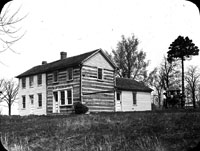
When did Joseph Smith abandon the policy of polygamy? How did he rationalize this shift in church policy?
Joseph Smith never abandoned the practice of polygamy; however, in the February 1, 1844 issue of the Latter-day Saints newspaper Times and Seasons, Smith and his brother Hyrum, co-presidents of the church, did publish a notice stipulating that Hiram Brown, a church elder in Michigan, had been cut off from the church for "preaching Polygamy, and other false and corrupt doctrines."
The renowned scholar Richard L. Bushman, who identifies himself as a "believing historian," asserts that rather than indicating a shift in church policy, the February 1844 edict comported with Smith's sermons and public statements of the period. On the pulpit, Smith vigorously denounced "adultery fornication" and polygamy, while in private, he revealed to trustworthy individuals and small groups within the church a revelation he had experienced that served to encourage and sanctify plural marriages that had been commanded by God, drawing on Old Testament practices as precedents. Smith ritualized the practice of polygamy through the institution of "sealing" couples together by priests of the church for eternity, thus allowing them to procreate eternally and achieve celestial glory. Smith denounced as adulterous polygamous practices that had not been sanctified by the church. Bushman concedes, "The distinction between priesthood calls to take additional wives and unlicensed indulgence was clear to him [Smith] if not always to others."
John C. Bennett, the co-founder with Smith of the Latter-day Saint town of Nauvoo, Illinois, and its first mayor, had been excommunicated two years earlier after telling numerous women in the community "that illicit sexual intercourse was acceptable if kept secret," according to Bushman. The February 1844 edict implied an attempt to disassociate the church from such rogue missionaries as Bennett and Brown, especially during a period in which Smith had become a candidate for the presidency of the United States. The church doctrine of sanctified plural marriages was not acknowledged publicly until 1852, eight years after Smith's assassination. In 1890, due to pressure from the federal government, the church issued a manifesto announcing that it no longer sanctioned plural marriages. Subsequent edicts in 1904 and 1910 threatened excommunication to church members and priests who entered into or performed new plural marriages.
Richard L. Bushman, with the assistance of Jed Woodworth, Joseph Smith: Rough Stone Rolling. New York: Knopf, 2005.
Donna Hill, Joseph Smith, The First Mormon. Salt Lake City, Utah: Signature Books, 1977.
Kathryn M. Daynes, More Wives Than One: Transformation of the Mormon Marriage System, 18401910. Urbana, Ill. and Chicago: University of Illinois Press, 2001.
Emma Goldman Papers

Emma Goldman (18691940) was a major figure in the radical and feminist movements in the United States prior to her deportation in 1919. This collection of primary resources includes selections from four books by Goldman as well as 18 published essays and pamphlets, four speeches, 49 letters, and five newspaper accounts of Goldman's activities.
There are also nearly 40 photographs, illustrations, and facsimiles of documents. Additional items include two biographical exhibitions, selections from a published guide of documentary sources, and four sample documents from the book edition of her papers. A curriculum for students is designed to aid the study of freedom of expression, women's rights, anti-militarism, and social change. The site offers essays on the project's history and bibliographic references as well as links to other websites.
Do History: Martha Ballard's Diary Online
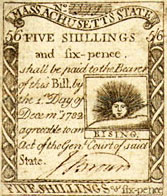
This interactive case study explores the 18th-century diary of midwife Martha Ballard and the construction of two late 20th-century historical studies based on the diary: historian Laurel Thatcher Ulrich's book A Midwife's Tale and Laurie Kahn-Leavitt's PBS film by the same name.
The site provides facsimile and transcribed full-text versions of the 1,400-page diary. An archive offers images of more than 50 documents on such topics as Ballard's life, domestic life, law and justice, finance and commerce, geography and surveying, midwifery and birth, medical information, religion, and Maine history. Also included are five maps, present-day images of Augusta and Hallowell, ME, and a timeline tracing Maine's history, the history of science and medicine, and a history of Ballard and Hallowell. The site offers suggestions on using primary sources to conduct research, including essays on reading 18th-century writing and probate records, searching for deeds, and exploring graveyards. A bibliography offers nearly 150 scholarly works and nearly 50 websites.
Annie Oakley

Born Phoebe Ann Moses in 1860 in rural Ohio, Annie Oakley became one of the most famous female entertainers of her day, performing for many years with Buffalo Bill's Wild West Show. Her life spanned a time of dramatic cultural change in the United States, and some of the most important years of the women's movement. This website accompanies a film on Oakley's life and work. While offering only a few primary sources, the website is rich with secondary source documentation. Users unfamiliar with Oakley's story may want to begin with the extensive timeline of her life, which traces her early years on a poor farm in Ohio, her involvement with the Wild West Show in the 1880s, 1890s, and early 1900s, the libel lawsuits she filed against 55 newspapers in the early 1900s, and her later years teaching women to shoot and raising funds for World War I.
The website includes profiles of 10 major people and events in Oakley's life, illustrated with thumbnail-sized photographs, as well as more extensive information on the Wild West Show's stints in New York City in the mid-1880s, including transcriptions from New York newspapers describing the shows. A gallery of six posters from the Wild West Show showcases Oakley's fame as one of the greatest marksmen of her time. The website also includes a transcript of the film, with extensive commentary by scholars of Oakley's life.
Kate and Sue McBeth, Missionary Teachers to the Nez Perce
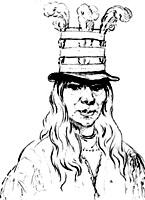
Presenting full-text letters and diaries, this website focuses on the lives and careers of Kate and Sue McBeth, missionaries and teachers among the Nez Perce Indians during the last quarter of the 19th century. Government documents and images pertaining to the tribe's history accompany these materials. Sue McBeth established a successful theological seminary for Nez Perce men, collected and organized a Nez Perce/English dictionary, and wrote journal articles. Kate McBeth provided literacy education for Nez Perce women, taught Euro-American domestic skills, and directed a Sabbath school and mission society.
Divided into five sections, materials include more than 150 letters, a diary, a journal, five treaties, more than 70 commission and agency reports and legislative actions, excerpts from a history of the Nez Perce, and 19 biographies. Six maps and approximately 100 images, including 13 illustrations depicting the 1855 Walla Walla Treaty negotiations, are also available.
American Indian Women
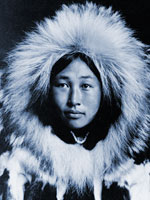
What were women treated like in the tribes of the Indians? Were they given more rights than American women of the time?
In 1644, the Rev. John Megalopensis, minister at a Dutch Church in New Netherlands, complained that Native American women were “obliged to prepare the Land, to mow, to plant, and do every Thing; the Men do nothing except hunting, fishing, and going to War against their Enemies. . .” Many of his fellow Europeans described American Indian women as “slaves” to the men, because of the perceived differences in their labor, compared to European women. Indian women performed what Europeans considered to be men’s work. But, from the Native American perspective, women’s roles reflected their own cultural emphases on reciprocity, balance, and autonomy. Most scholars agree that Native American women at the time of contact with Europeans had more authority and autonomy than did European women.
It is hard to make any generalizations about indigenous societies, because North America’s First Peoples consisted of hundreds of separate cultures, each with their own belief systems, social structures, and cultural and political practices. Evidence is particularly scarce about women’s everyday lives and responsibilities. However, most cultures shared certain characteristics that promoted gender equality.
Kinship, extended family, and clan bound people together within a system of mutual obligation and respect. Lineage was central to determining status and responsibilities, consent held communities together, and concepts of reciprocity extended to gender roles and divisions of authority.
Men were generally responsible for hunting, warfare, and interacting with outsiders, therefore they had more visible, public roles. Women, on the other hand, managed the internal operations of the community. They usually owned the family’s housing and household goods, engaged in agricultural food production and gathering of foodstuffs, and reared the children.
Because women’s activities were central to the community’s welfare, they also held important political, social, and economic power. In many North American societies, clan membership and material goods descended through women. For example, the Five (later Six) Nations of the Iroquois Confederation all practiced matrilineal descent. Clan matrons selected men to serve as their chiefs, and they deposed chiefs with whom they were dissatisfied. Women’s life-giving roles also played a part in their political and social authority. In Native American creation stories, it was often the woman who created life, through giving birth to children, or through the use of their own bodies to create the earth, from which plants and animals emerged.
Some scholars argue that, after contact, women’s authority steadily declined because of cultural assimilation. Euro-American men insisted on dealing with Indian men in trade negotiations, and ministers demanded that Indians follow the Christian modes of partriarchy and gendered division of labor that made men farmers and women housekeepers.
However, other scholars, such as SUNY Fredonia anthropologist Joy Bilharz and University of North Carolina historian Theda Perdue, argue that many indigenous women maintained authority within their communities. Matrilineal inheritance of clan identity remained important parts of many cultures long after contact, and women continued to use their maternal authority to influence political decisions within and outside of their own nations.
For example, as the United States increased pressure against the Cherokee nation to relinquish their eastern lands and move west, groups of Cherokee women petitioned their Council to stand their ground. In these communications, they sternly reminded their “[b]eloved children” that they had raised the Council members on that land which “God gave us to inhabit and raise provisions.” They admonished their children not to “part with any more lands.”
Another Cherokee woman wrote to Benjamin Franklin in 1787, advocating peace between the new United States and the Cherokee nation. She advised Franklin that political leaders “. . . ought to mind what a woman says, and look upon her as a mother – and I have Taken the prevelage to Speak to you as my own Children . . . and I am in hopes that you have a beloved woman amongst you who will help to put her children right if they do wrong, as I shall do the same. . . . ” American Indian women assumed that their unique positions in their societies gave them the right to play the mother card when necessary.
Primary Documents:
John Megalopensis, “A Dutch Minister Describes the Iroquois.” Albert Bushnell Hart, ed., American History Told by Contemporaries, vol. I. New York: 1898.
Petitions of the Women’s Councils, Petition, May 2, 1817 in Presidential Papers Microfilm: Andrew Jackson. Library of Congress, series 1, reel 22.
“Letter from Cherokee Indian Woman to Benjamin Franklin, Governor of the State of Pennsylvania,” Paul Lauter et al., eds, The Heath Anthology of American Literature, Volume A: Beginnings to 1800, 6th ed. New York: 2009.
For Further Reading:
Joy Bilharz, “First Among Equals? The Changing Status of Seneca Women” in Laura F. Klein, ed., Women and Power in Native North America. Norman, Ok.: 1995. 101-112.
Theda Perdue, Cherokee Women: Gender and Culture Change, 1700-1835. Lincoln, Neb: 1998.
Nancy Shoemaker, ed., Negotiators of Change: Historical Perspectives on Native American Women. New York: 1995.
Images:
"Obleka, an Eskimo woman," Frank Nowell, 1907. Prints and Photographs Division, Library of Congress.
"Kutenai woman," Edward Curtis, 1910. Prints and Photographs Division, Library of Congress.
Native American Customs of Childbirth
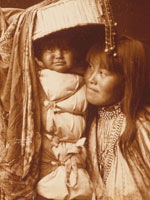
How did Native American women give birth, or what were their practices or beliefs in giving birth?
In the seventeenth century, Dutchman Adrien Van der Donck described a woman’s preparation for childbirth among the Mohawk and Mahican Indians in what is now known as New York. He stated that pregnant women would “depart alone to a secluded place near a brook, or stream of water . . . and prepare a shelter for themselves with mats and coverings, where, provided with provisions necessary for them, they await their delivery without the company or aid of any person. . . . They rarely are sick from child-birth [and] suffer no inconveniences from the same.” Many similar descriptions of solitary, painless births exist among European observers of the Native Americans, but because most of these observers were men, and men rarely attended the birth of children, these descriptions are probably inaccurate. Although each indigenous culture had its own unique beliefs and rituals about childbirth, scholars believe that many First Peoples shared certain practices involving the participation of close family members and select others within the community.
During their pregnancies, women restricted their activities and took special care with their diet and behavior to protect the baby. The Cherokees, for example, believed that certain foods affected the fetus. Pregnant women avoided foods that they believed would harm the baby or cause unwanted physical characteristics. For example, they believed that eating raccoon or pheasant would make the baby sickly, or could cause death; consuming speckled trout could cause birthmarks; and eating black walnuts could give the baby a big nose. They thought that wearing neckerchiefs while pregnant caused umbilical strangulation, and lingering in doorways slowed delivery. Expectant mothers and fathers participated in rituals to guarantee a safe delivery, such as daily washing of hands and feet and employing medicine men to perform rites that would make deliveries easier.
As the birth grew closer, women and their families observed other rituals to ensure an easy and healthy birth. Nineteenth-century anthropologist James Mooney recorded one Cherokee ritual intended to frighten the child out of the mother’s womb. A female relative of the mother would say: “Listen! You little man, get up now at once. There comes an old woman. The horrible [old thing] is coming, only a little way off. Listen! Quick! Get your bed and let us run away. Yu!” The female relative then repeated the formula, substituting “little woman” and “your grandfather,” in case the baby was a girl. Van der Donck described a Mahican concoction made of root bark that the mother drank shortly before labor began. Many indigenous peoples used similar remedies. Cherokee women drank an infusion of wild cherry bark to speed delivery.
Despite numerous descriptions of solitary births, other accounts describe births attended by a midwife and other close family members. Men were rarely allowed in the birth room, and they were never allowed to see the birth. A woman in labor stood, knelt, or sat, but she never gave birth lying down. Usually no one bothered to catch the baby, who fell onto leaves placed beneath the mother. Van der Donck and Mooney described post-delivery rituals in which the mothers ceremonially plunged the infant into the river, an act they repeated daily for two years. British Lieutenant Henry Timberlake, an envoy to the Cherokee in the mid-eighteenth century, stated that this ritual made “the children acquire such strength, that no ricketty or deformed are found among them.”
European descriptions of Native American women’s quick recovery from childbirth may have been exaggerated. But generally, Indian women’s excellent physical conditioning certainly aided in their recovery from childbirth. Barring any serious complications – which, of course, did happen occasionally – Native American women returned to their regular duties in a very short period of time.
Perdue, Theda, Cherokee Women: Gender and Culture Change, 1700-1835. Lincoln: University of Nebraska Press, 1998.
Rountree, Helen. “Powhatan Indian Women: The People Capt. John Smith Barely Saw.” Ethnohistory, 45 (1998) 1-29.
Shoemaker, Nancy, ed., Negotiators of Change: Historical Perspectives on Native American Women. New York: Routledge, 1995.
Adrien Van der Donck, “A Description of the New Netherlands,” 2d ed. (Amsterdam, 1656), trans. Jeremiah Johnson, in Collections of the New-York Historical Society, 2d ser., 1 (1841).
James Mooney, Myths of the Cherokee. New York: Johnson Reprint Corp., 1970.
Lieut. Henry Timberlake, Memoirs of Lieutenant Henry Timberlake: The Story of a Soldier, Adventurer, and Emissary to the Cherokees, 1756-1765. Ed. Duane H. King. Chapel Hill: University of North Carolina Press, 2007.
Women in America: 1820 to 1842
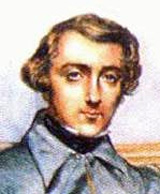
This site, created by a graduate student, presents fragments of 18 texts that discuss the condition of women written by visitors to the United States between 1820 to 1842. Authors include Charles Dickens, Alexis de Tocqueville, Charles Lyell, Michel Chevalier, and James Fenimore Cooper. The 13 topics include marriage and courtship, work, government, education, race, arts and entertainment, fashion, travel, prisons, wilderness, health, Indians, and religion. The primary purpose of the site—to ascertain the accuracy of "the picture of women in [Tocqueville's] Democracy in America" and "what parts of women's lives" Tocqueville and [Gustave de] Beaumont "missed"—suggests that it is best regarded as an exercise in simple description, not interpretation or even exposition of the texts. These particular concerns indeed mean that users will not be able to draw conclusions about Tocqueville's social or political theory, for instance, since the site does not ask what the omissions actually mean for the texts involved. The site is useful on its own terms, which some students may find compelling. But others may find it narrow and awkward. In either case, it should be read with questions of context and purpose in mind. Also offers a 20-item bibliography.